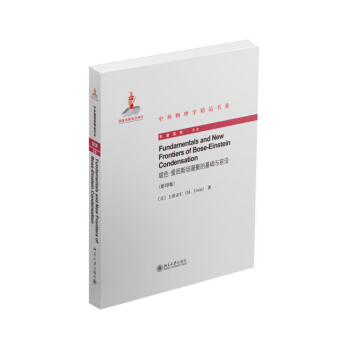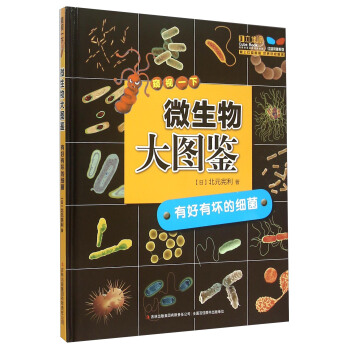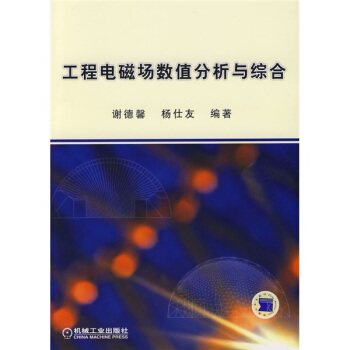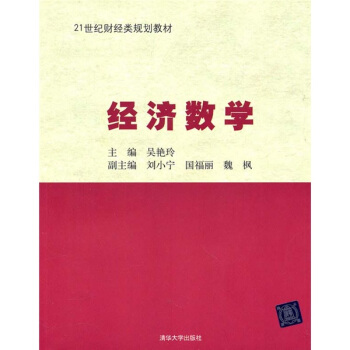

具体描述
编辑推荐
玻色爱因斯坦凝聚是神奇而富有魅力的物理现象。相关研究已经使多位科学家获得了诺贝尔奖。目前。关于冷原子的研究正蓬勃展开,玻色爱因斯坦凝聚正是其理论基础。《中外物理学精品书系:玻色-爱因斯坦凝聚的基础与前沿(英文影印版)》对于相关领域的研究人员来说是不可错过的佳作。内容简介
《中外物理学精品书系:玻色-爱因斯坦凝聚的基础与前沿(英文影印版)》首先介绍了玻色-爱因斯坦凝聚(BEC)的基本理论。之后,《中外物理学精品书系:玻色-爱因斯坦凝聚的基础与前沿(英文影印版)》讨论了快速旋转BEC,旋量和偶极BEC,低维BEC等近来发展迅速的方向。本书还介绍了平衡或非平衡费米液体超流,包括BCS-BEC交叉、幺正气体、p波超流等。本书适合本领域的研究者和研究生阅读。作者简介
(日)上田正仁,日本东京大学教授。目录
Preface v1. Fundamentals of Bose-Einstein Condensation 1
1.1 Indistinguishability of Identical Particles . . . . . . . . . . 1
1.2 Ideal Bose Gas in a Uniform System . . . . . . . . . . . . 3
1.3 Off-Diagonal Long-Range Order: Bose System . . . . . . 6
1.4 Off-Diagonal Long-Range Order: Fermi System . . . . . . 10
1.5 U(1)Gauge Symmetry . . . . . . . . . . . . . . . . . . . . 11
1.6 Ground-State Wave Function of a Bose System . . . . . . 13
1.7 BEC and Superfluidity . . . . . . . . . . . . . . . . . . . . 15
1.8 Two-FluidModel . . . . . . . . . . . . . . . . . . . . . . . 20
1.9 Fragmented Condensate . . . . . . . . . . . . . . . . . . . 23
1.9.1 Two-statemodel . . . . . . . . . . . . . . . . . . . 23
1.9.2 Degenerate double-well model . . . . . . . . . . . 25
1.9.3 Spin-1 antiferromagnetic BEC . . . . . . . . . . . 27
1.10 Interference Between Independent Condensates . . . . . . 28
1.11 Feshbach Resonance . . . . . . . . . . . . . . . . . . . . . 31
2. Weakly Interacting Bose Gas 33
2.1 Interactions Between Neutral Atoms . . . . . . . . . . . . 33
2.2 Pseudo-PotentialMethod . . . . . . . . . . . . . . . . . . 36
2.3 Bogoliubov Theory . . . . . . . . . . . . . . . . . . . . . . 40
2.3.1 Bogoliubov transformations . . . . . . . . . . . . . 40
2.3.2 Bogoliubov ground state . . . . . . . . . . . . . . 45
2.3.3 Low-lying excitations and condensate fraction . . 48
2.3.4 Properties of Bogoliubov ground state . . . . . . . 50
2.4 Bogoliubov Theory of Quasi-One-Dimensional Torus . . . 54
2.4.1 Case of BEC at rest: stability of BEC . . . . . . . 55
2.4.2 Case of rotating BEC: Landau criterion . . . . . . 56
2.4.3 Ground state of BEC in rotating torus . . . . . . 59
2.5 Bogoliubov-deGennes (BdG) Theory . . . . . . . . . . . 60
2.6 Method of Binary Collision Expansion . . . . . . . . . . . 65
2.6.1 Equation of state . . . . . . . . . . . . . . . . . . 65
2.6.2 Cluster expansion of partition function . . . . . . 66
2.6.3 Ideal Bose and Fermi gases . . . . . . . . . . . . . 67
2.6.4 Matsubara formula . . . . . . . . . . . . . . . . . 69
3. Trapped Systems 73
3.1 Ideal Bose Gas in a Harmonic Potential . . . . . . . . . . 73
3.1.1 Transition temperature . . . . . . . . . . . . . . . 75
3.1.2 Condensate fraction . . . . . . . . . . . . . . . . . 76
3.1.3 Chemical potential . . . . . . . . . . . . . . . . . 77
3.1.4 Specific heat . . . . . . . . . . . . . . . . . . . . . 77
3.2 BEC in One- and Two-Dimensional Parabolic Potentials . 79
3.2.1 Density of states . . . . . . . . . . . . . . . . . . . 79
3.2.2 Transition temperature . . . . . . . . . . . . . . . 79
3.2.3 Condensate fraction . . . . . . . . . . . . . . . . . 80
3.3 Semiclassical Distribution Function . . . . . . . . . . . . . 81
3.4 Gross-Pitaevskii Equation . . . . . . . . . . . . . . . . . . 83
3.5 Thomas-Fermi Approximation . . . . . . . . . . . . . . . 84
3.6 Collective Modes in the Thomas-Fermi Regime . . . . . . 88
3.6.1 Isotropic harmonic potential . . . . . . . . . . . . 89
3.6.2 Axisymmetric trap . . . . . . . . . . . . . . . . . 91
3.6.3 Scissorsmode . . . . . . . . . . . . . . . . . . . . 92
3.7 VariationalMethod . . . . . . . . . . . . . . . . . . . . . . 93
3.7.1 Gaussian variational wave function . . . . . . . . 94
3.7.2 Collectivemodes . . . . . . . . . . . . . . . . . . . 96
3.8 Attractive Bose-Einstein Condensate . . . . . . . . . . . . 98
3.8.1 Collectivemodes . . . . . . . . . . . . . . . . . . . 99
3.8.2 Collapsing dynamics of an attractive condensate . 102
4. Linear Response and Sum Rules 105
4.1 Linear Response Theory . . . . . . . . . . . . . . . . . . . 105
4.1.1 Linear response of density fluctuations . . . . . . 105
4.1.2 Retarded response function . . . . . . . . . . . . . 108
4.2 Sum Rules . . . . . . . . . . . . . . . . . . . . . . . . . . . 109
4.2.1 Longitudinal f-sumrule . . . . . . . . . . . . . . 110
4.2.2 Compressibility sum rule . . . . . . . . . . . . . . 112
4.2.3 Zero energy gap theorem . . . . . . . . . . . . . . 114
4.2.4 Josephson sum rule . . . . . . . . . . . . . . . . . 115
4.3 Sum-Rule Approach to CollectiveModes . . . . . . . . . . 120
4.3.1 Excitation operators . . . . . . . . . . . . . . . . . 121
4.3.2 Virial theorem . . . . . . . . . . . . . . . . . . . . 122
4.3.3 Kohn theorem . . . . . . . . . . . . . . . . . . . . 123
4.3.4 Isotropic trap . . . . . . . . . . . . . . . . . . . . 124
4.3.5 Axisymmetric trap . . . . . . . . . . . . . . . . . 127
5. Statistical Mechanics of Superfluid Systems in a Moving Frame 129
5.1 Transformation toMoving Frames . . . . . . . . . . . . . 129
5.2 Elementary Excitations of a Superfluid . . . . . . . . . . . 131
5.3 Landau Criterion . . . . . . . . . . . . . . . . . . . . . . . 133
5.4 Correlation Functions at Thermal Equilibrium . . . . . . 134
5.5 Normal Fluid Density . . . . . . . . . . . . . . . . . . . . 136
5.6 Low-Lying Excitations of a Superfluid . . . . . . . . . . . 140
5.7 Examples . . . . . . . . . . . . . . . . . . . . . . . . . . . 141
5.7.1 Ideal Bose gas . . . . . . . . . . . . . . . . . . . . 141
5.7.2 Weakly interacting Bose gas . . . . . . . . . . . . 143
6. Spinor Bose-Einstein Condensate 145
6.1 Internal Degrees of Freedom . . . . . . . . . . . . . . . . . 145
6.2 General Hamiltonian of Spinor Condensates . . . . . . . . 146
6.3 Spin-1 BEC . . . . . . . . . . . . . . . . . . . . . . . . . . 151
6.3.1 Mean-field theory of a spin-1 BEC . . . . . . . . . 153
6.3.2 Many-body states in single-mode approximation . 157
6.3.3 Superflow, spin texture, and Berry phase . . . . . 161
6.4 Spin-2 BEC . . . . . . . . . . . . . . . . . . . . . . . . . . 163
7. Vortices 171
7.1 Hydrodynamic Theory of Vortices . . . . . . . . . . . . . 171
7.2 Quantized Vortices . . . . . . . . . . . . . . . . . . . . . . 174
7.3 Interaction Between Vortices . . . . . . . . . . . . . . . . 180
7.4 Vortex Lattice . . . . . . . . . . . . . . . . . . . . . . . . 181
7.4.1 Dynamics of vortex nucleation . . . . . . . . . . . 181
7.4.2 Collective modes of a vortex lattice . . . . . . . . 183
7.5 FractionalVortices . . . . . . . . . . . . . . . . . . . . . . 186
7.6 Spin Current . . . . . . . . . . . . . . . . . . . . . . . . . 187
7.7 Fast Rotating BECs . . . . . . . . . . . . . . . . . . . . . 189
7.7.1 Lowest Landau level approximation . . . . . . . . 189
7.7.2 Mean field quantum Hall regime . . . . . . . . . . 192
7.7.3 Many-body wave functions of a fast
rotating BEC . . . . . . . . . . . . . . . . . . . . 194
8. Fermionic Superfluidity 197
8.1 Ideal Fermi Gas . . . . . . . . . . . . . . . . . . . . . . . . 197
8.2 Fermi Liquid Theory . . . . . . . . . . . . . . . . . . . . . 200
8.3 Cooper Problem . . . . . . . . . . . . . . . . . . . . . . . 205
8.3.1 Two-body problem . . . . . . . . . . . . . . . . . 205
8.3.2 Many-body problem . . . . . . . . . . . . . . . . . 209
8.4 Bardeen-Cooper-Schrieffer (BCS) Theory . . . . . . . . . 211
8.5 BCS-BEC Crossover at T =0 . . . . . . . . . . . . . . . . 215
8.6 Superfluid Transition Temperature . . . . . . . . . . . . . 219
8.7 BCS-BEC Crossover at T _=0 . . . . . . . . . . . . . . . . 221
8.8 Gor'kov-Melik-Barkhudarov Correction . . . . . . . . . . 225
8.9 Unitary Gas . . . . . . . . . . . . . . . . . . . . . . . . . . 228
8.10 Imbalanced Fermi Systems . . . . . . . . . . . . . . . . . . 231
8.11 P-Wave Superfluid . . . . . . . . . . . . . . . . . . . . . . 234
8.11.1 Generalized pairing theory . . . . . . . . . . . . . 234
8.11.2 Spin-triplet p-wave states . . . . . . . . . . . . . . 238
9. Low-Dimensional Systems 241
9.1 Non-interacting Systems . . . . . . . . . . . . . . . . . . . 241
9.2 Hohenberg-Mermin-Wagner Theorem . . . . . . . . . . . 243
9.3 Two-Dimensional BEC at Absolute Zero . . . . . . . . . . 246
9.4 Berezinskii-Kosterlitz-Thouless Transition . . . . . . . . . 247
9.4.1 Universal jump . . . . . . . . . . . . . . . . . . . . 247
9.4.2 Quasi long-range order . . . . . . . . . . . . . . . 249
9.4.3 Renormalization-group analysis . . . . . . . . . . 250
9.5 Quasi One-Dimensional BEC . . . . . . . . . . . . . . . . 252
9.6 Tonks-Girardeau Gas . . . . . . . . . . . . . . . . . . . . 256
9.7 Lieb-LinigerModel . . . . . . . . . . . . . . . . . . . . . . 258
10. Dipolar Gases 261
10.1 Dipole-Dipole Interaction . . . . . . . . . . . . . . . . . . 261
10.1.1 Basic properties . . . . . . . . . . . . . . . . . . . 261
10.1.2 Order of magnitude and length scale . . . . . . . 263
10.1.3 D-wave nature . . . . . . . . . . . . . . . . . . . . 264
10.1.4 Tuning the dipole-dipole interaction . . . . . . . . 265
10.2 PolarizedDipolar BEC. . . . . . . . . . . . . . . . . . . . 266
10.2.1 Nonlocal Gross-Pitaevskii equation . . . . . . . . 266
10.2.2 Stability . . . . . . . . . . . . . . . . . . . . . . . 267
10.2.3 Thomas-Fermi limit . . . . . . . . . . . . . . . . . 269
10.2.4 Quasi two-dimensional systems . . . . . . . . . . . 271
10.3 Spinor-Dipolar BEC . . . . . . . . . . . . . . . . . . . . . 273
10.3.1 Einstein-de Haas effect . . . . . . . . . . . . . . . 274
10.3.2 Flux closure and ground-state circulation . . . . . 274
11. Optical Lattices 277
11.1 Optical Potential . . . . . . . . . . . . . . . . . . . . . . . 277
11.1.1 Optical trap . . . . . . . . . . . . . . . . . . . . . 277
11.1.2 Optical lattice . . . . . . . . . . . . . . . . . . . . 280
11.2 Band Structure . . . . . . . . . . . . . . . . . . . . . . . . 283
11.2.1 Bloch theorem . . . . . . . . . . . . . . . . . . . . 283
11.2.2 Brillouin zone . . . . . . . . . . . . . . . . . . . . 285
11.2.3 Bloch oscillations . . . . . . . . . . . . . . . . . . 286
11.2.4 Wannier function . . . . . . . . . . . . . . . . . . 287
11.3 Bose-Hubbard Model . . . . . . . . . . . . . . . . . . . . 288
11.3.1 Bose-Hubbard Hamiltonian . . . . . . . . . . . . 288
11.3.2 Superfluid-Mott-insulator transition . . . . . . . . 289
11.3.3 Phase diagram . . . . . . . . . . . . . . . . . . . . 291
11.3.4 Mean-field approximation . . . . . . . . . . . . . . 292
11.3.5 Supersolid . . . . . . . . . . . . . . . . . . . . . . 295
12. Topological Excitations 297
12.1 Homotopy Theory . . . . . . . . . . . . . . . . . . . . . . 297
12.1.1 Homotopic relation . . . . . . . . . . . . . . . . . 297
12.1.2 Fundamental group . . . . . . . . . . . . . . . . . 299
12.1.3 Higher homotopy groups . . . . . . . . . . . . . . 302
12.2 Order Parameter Manifold . . . . . . . . . . . . . . . . . . 303
12.2.1 Isotropy group . . . . . . . . . . . . . . . . . . . . 303
12.2.2 Spin-1 BEC . . . . . . . . . . . . . . . . . . . . . 304
12.2.3 Spin-2 BEC . . . . . . . . . . . . . . . . . . . . . 305
12.3 Classification of Defects . . . . . . . . . . . . . . . . . . . 306
12.3.1 Domains . . . . . . . . . . . . . . . . . . . . . . . 306
12.3.2 Line defects . . . . . . . . . . . . . . . . . . . . . 306
12.3.3 Point defects . . . . . . . . . . . . . . . . . . . . . 311
12.3.4 Skyrmions . . . . . . . . . . . . . . . . . . . . . . 313
12.3.5 Influence of different types of defects . . . . . . . 316
12.3.6 Topological charges . . . . . . . . . . . . . . . . . 318
Appendix A Order of Phase Transition, Clausius-Clapeyron
Formula, and Gibbs-Duhem Relation 321
Appendix B Bogoliubov Wave Functions in Coordinate Space 323
B.1 Ground-State Wave Function . . . . . . . . . . . 323
B.2 One-Phonon State . . . . . . . . . . . . . . . . . 327
Appendix C Effective Mass, Sound Velocity, and Spin
Susceptibility of Fermi Liquid 329
Appendix D Derivation of Eq. (8.155) 333
Appendix E f -Sum Rule 335
Bibliography 337
Index 347
前言/序言
用户评价
这本书的到来,简直是为我这个对量子世界着迷的“发烧友”量身定做的。我一直对BEC那种“不可思议”的超宏观量子态感到着迷,仿佛是把微观世界的奇异规则直接搬到了宏观尺度上,让人忍不住想一探究竟。我非常期待书中能够细致地讲解BEC的“诞生”过程,从超冷原子技术的飞跃,到激光冷却和蒸发冷却的精妙设计,再到如何通过这些手段将原子冷却到纳开尔温标以下,最终“凝结”成BEC。我对那些具体的实验技术细节非常感兴趣,比如各种光镊、磁阱的原理和应用,以及如何精确地控制和探测BEC的性质。书中是否有关于如何搭建实验装置的图解或描述?或者对于不同实验体系(例如碱金属原子、碱土金属原子、分子BEC等)的优缺点进行比较分析?这些细节对于我理解BEC的实验实现具有至关重要的意义。而且,我对于BEC的各种奇特性质,比如零粘度、长程相干性、量子涡旋等等,都有着强烈的好奇心,渴望书中能够用清晰的语言和翔实的例子来解释这些现象背后的物理机制。
评分收到这本书,我最大的感受就是它给我带来了一种“沉浸式”的学习体验。英文影印版保留了原文的精髓,这意味着我可以直接接触到最前沿的研究成果和最地道的学术表达方式。我尤其欣赏那种“大咖云集”的学术氛围,很多时候,一本好的教材不仅仅是知识的传授,更是思想的启迪。我希望书中能够涵盖不同研究团队的观点和方法,展示出BEC研究领域的多样性和活力。例如,在对BEC的相变进行描述时,书中是否会对比不同理论模型(如Landau-Ginzburg理论、临界现象理论等)的解释?在探讨BEC的应用时,是否会介绍来自不同学科(如光学、材料科学、甚至生物学)的交叉研究成果?我非常期待这本书能够激发我的独立思考能力,让我学会如何批判性地看待科学问题,并从中学习如何提出自己的见解。这本书的出版,本身就是对“中外物理学精品”理念的一种诠释,我希望它能成为连接国内外学术界的重要桥梁。
评分终于收到这本梦寐以求的《中外物理学精品书系:玻色-爱因斯坦凝聚的基础与前沿(英文影印版)》了!拿到手就迫不及待地翻看了封面,精美的设计和厚实的纸张触感,瞬间点燃了我对书中内容的期待。作为一名在凝聚态物理领域摸爬滚打了数年的研究生,我一直对玻色-爱因斯坦凝聚(BEC)这个奇妙而深刻的量子现象充满好奇。它不仅是量子统计力学中的一个里程碑式的成就,更是通往超流、超导等一系列宏观量子现象的关键钥匙。我尤其关注书中是否能够深入浅出地介绍BEC的理论基础,比如从量子统计力学的基本原理出发,如何推导出BEC的形成条件和性质;以及它与传统气体统计的根本区别在哪里。同时,作为“前沿”的组成部分,我期望书中能详细阐述近年来在BEC研究领域取得的突破性进展,例如在原子干涉、量子模拟、高精度测量等方面的应用,以及一些前沿课题的研究方向,如非平衡态BEC、多体纠缠态、拓扑BEC等等。这本书的英文影印版,也意味着我能够直接接触到最原始、最权威的学术思想和研究方法,这对于提升我的学术视野和英文阅读能力都大有裨益。我非常期待通过这本书,能够进一步夯实我的理论基础,拓宽我的研究思路,甚至激发新的研究灵感。
评分作为一名对物理学史和科学思想发展充满兴趣的读者,我特别看重一本好的学术著作所能提供的历史视角和思想深度。这本书的“精品书系”定位,让我相信它不仅仅是一本技术性的教科书,更可能蕴含着作者对BEC发展历程的深刻洞察。我希望书中能够追溯BEC概念的起源,从玻色-爱因斯坦的开创性工作,到后续的理论发展和实验验证,脉络清晰地展现这一重要概念如何一步步走向成熟。书中是否会提及一些关键的科学家和他们的贡献?他们是如何一步步攻克理论和实验上的难关的?我很想了解BEC研究背后的人文故事和科学精神。同时,我也对BEC研究对其他物理学分支的影响感到好奇。它是否对凝聚态物理的其他领域,比如量子信息、量子计算、高能物理等产生了深远的影响?或者,BEC的研究是否也从其他领域汲取了养分,从而得以蓬勃发展?我希望这本书能帮助我建立一个更广阔的物理学知识体系,理解BEC在整个科学图景中的位置。
评分我最近正在为我的毕业论文选题而苦恼,而BEC恰恰是我非常感兴趣的一个方向。我希望这本书能够提供一些前沿的、具有潜在研究价值的课题方向。书中是否会深入探讨一些尚未完全解决的科学难题?例如,在强相互作用BEC、低维度BEC、或涉及复杂粒子相互作用的BEC体系中,有哪些值得进一步探索的物理现象?我希望书中能够提供一些最新的实验结果和理论模型的梳理,并对未来的研究趋势做出展望。对于我这样即将走上科研道路的学生来说,能够提前接触到这些前沿信息,无疑是宝贵的财富。我特别关注书中是否会涉及一些具体的数学工具和计算方法,这些是进行理论研究不可或缺的。例如,对于描述BEC的Gross-Pitaevskii方程,书中是否会详细介绍其推导过程和求解方法?对于更复杂的相互作用,是否会引入量子场论或其他先进的理论框架?我希望这本书能够成为我论文选题和研究的有力助手。
评分好
评分《中外物理学精品书系:超冷量子气体》将介绍超冷原子和分子体系中的少体和多体物理性质。拟包括的内容有:超冷原子物理发展回顾与简介,原子结构,散射理论基础,激光冷却与原子捕陷,玻色爱因斯坦凝聚,Feshbach共振,超冷费米气体中的BCS-BEC过渡,光晶格中的超冷原子物理与量子仿真,准低维系统(包括少体问题和多体问题),超冷分子和超冷化学,基于超冷原子的量子调控,以及超冷量子气体的最新进展等。《中外物理学精品书系:超冷量子气体》的目标读者是物理专业高年级研究生以及对本领域有兴趣的研究人员,通过综述近十余年研究的最新进展,期望对他们进入该领域有所帮助。
评分玻色爱因斯坦凝聚是神奇而富有魅力的物理现象。相关研究已经使多位科学家获得了诺贝尔奖。目前。关于冷原子的研究正蓬勃展开,玻色爱因斯坦凝聚正是其理论基础。《中外物理学精品书系:玻色-爱因斯坦凝聚的基础与前沿(英文影印版)》对于相关领域的研究人员来说是不可错过的佳作。
评分买来当参考书,看完再追加评论。
评分京东方便快捷!下次还买!赞一个!
评分专业书籍,很好,喜欢
评分好好好好好好好好好好好好好好好好好好
评分内容丰富,语言易懂,是本难得的BEC方面的好书。
评分书面很脏
相关图书
本站所有内容均为互联网搜索引擎提供的公开搜索信息,本站不存储任何数据与内容,任何内容与数据均与本站无关,如有需要请联系相关搜索引擎包括但不限于百度,google,bing,sogou 等,本站所有链接都为正版商品购买链接。
© 2025 windowsfront.com All Rights Reserved. 静流书站 版权所有



![X射线荧光光谱分析(第二版) [X-Ray Fluoresecence Spectromentry] pdf epub mobi 电子书 下载](https://pic.windowsfront.com/11688402/5555bf4eNcdb0d704.jpg)









![混沌初开:自组织理论的哲学探索 [Chaos first open] pdf epub mobi 电子书 下载](https://pic.windowsfront.com/10080967/c49058a0-7da0-4396-b6cc-5843878b68b1.jpg)
![天元基金影印数学丛书:分析2(影印版) [Analysis Ⅱ] pdf epub mobi 电子书 下载](https://pic.windowsfront.com/10126498/56722a96N4b1afaa3.jpg)


![算术教程(英文版) [A Course in Arithmetic] pdf epub mobi 电子书 下载](https://pic.windowsfront.com/10184600/1a97631e-9708-4b40-8528-23dce5afd968.jpg)


